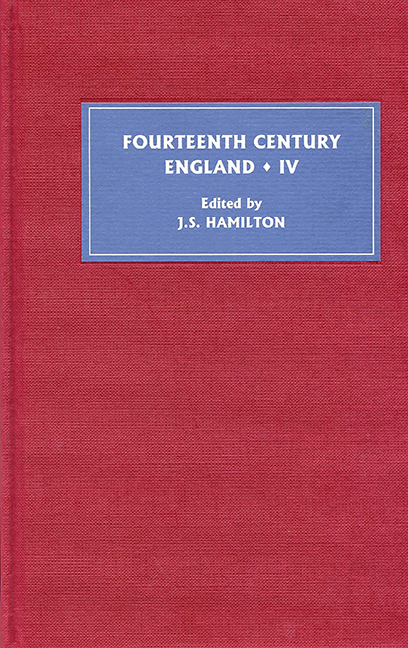Book contents
- Frontmatter
- Contents
- List of Illustrations
- Contributors
- Preface
- Abbreviations
- Who was St Thomas of Lancaster? New Manuscript Evidence
- ‘Hedging, Ditching and Other Improper Occupations’: Royal Landscapes and their Meaning under Edward II and Edward III
- Paying for the Wedding: Edward III as Fundraiser, 1332–3
- The Politics of Privilege: Thomas Hatfield and the Palatinate of Durham, 1345–81
- Agnes Maltravers (d. 1375) and her Husband John (d. 1364): Rebel Wives, Separate Lives, and Conjugal Visits in Later Medieval England
- Gendering Pastoral Care: John Mirk and his Instructions for Parish Priests
- Prosecution of the Statutes of Provisors and Premunire in the King's Bench, 1377–1394
- ‘Mercy and Truth Preserve the King’: Richard II's Use of the Royal Pardon in 1397 and 1398
- Aliens in the Pardons of Richard II
- ‘Too Flattering Sweet to be Substantial’? The Last Months of Thomas, Lord Despenser
- ‘O Prince, Desyre to be Honourable’: The Deposition of Richard II and Mirrors for Princes
- Regional Politics, Landed Society and the Coal Industry in North-East England, 1350–1430
Who was St Thomas of Lancaster? New Manuscript Evidence
Published online by Cambridge University Press: 12 September 2017
- Frontmatter
- Contents
- List of Illustrations
- Contributors
- Preface
- Abbreviations
- Who was St Thomas of Lancaster? New Manuscript Evidence
- ‘Hedging, Ditching and Other Improper Occupations’: Royal Landscapes and their Meaning under Edward II and Edward III
- Paying for the Wedding: Edward III as Fundraiser, 1332–3
- The Politics of Privilege: Thomas Hatfield and the Palatinate of Durham, 1345–81
- Agnes Maltravers (d. 1375) and her Husband John (d. 1364): Rebel Wives, Separate Lives, and Conjugal Visits in Later Medieval England
- Gendering Pastoral Care: John Mirk and his Instructions for Parish Priests
- Prosecution of the Statutes of Provisors and Premunire in the King's Bench, 1377–1394
- ‘Mercy and Truth Preserve the King’: Richard II's Use of the Royal Pardon in 1397 and 1398
- Aliens in the Pardons of Richard II
- ‘Too Flattering Sweet to be Substantial’? The Last Months of Thomas, Lord Despenser
- ‘O Prince, Desyre to be Honourable’: The Deposition of Richard II and Mirrors for Princes
- Regional Politics, Landed Society and the Coal Industry in North-East England, 1350–1430
Summary
Medieval England was rife with national and local, official and unofficial cultic centers, drawing pilgrims up, down, and across the country. ‘From every shires ende/ Of Engelond, to Caunterbury they wende’, as well as to Durham, Oxford, Walsingham, Evesham, and a multitude of towns and villages in between. Medieval Christianity cleaved to a strong belief in the curative power of relics and places and the simple efficacy of the pilgrimage act. Every church and cathedral housed a relic of some saint or holy person, and claims of miracle cures wrought by the saint via their relic lured the pilgrims with their open coin purses to the shrine. Stories of saints, relics, and miracles passed along the pilgrimage roads and were discussed as hotly as any other gossip of the day. The number of popular pilgrimage centers multiplied throughout the thirteenth and fourteenth centuries, including officially sanctioned cults and the cults of unofficial political saints like Simon de Montfort and Thomas of Lancaster.
Thomas, earl of Lancaster, was executed for rebellion on 22 March 1322, and there arose a cult almost immediately at his execution site at Pontefract in Yorkshire. Devotees were drawn by rumors of miracles at the site and were surely intrigued by the immediacy of the act; this was not some long-dead holy man, but a high-ranking noble of their own time. Edward II endeavored to curtail the reverence paid to his executed cousin; however, his actions may only have prompted an increase in the popular devotion. Politics often played a part in pilgrimage, and during the civil disorder of the later 1320s Thomas of Lancaster became the saintly focus for those opposed to Edward II and the Despenser regime. Although he was never canonized, Lancaster was venerated as a saint who stood against an oppressive and unjust king.
- Type
- Chapter
- Information
- Fourteenth Century England IV , pp. 1 - 25Publisher: Boydell & BrewerPrint publication year: 2006



